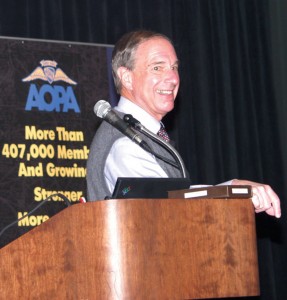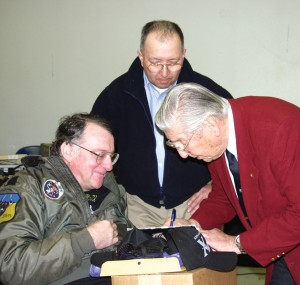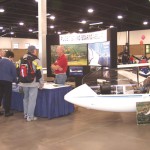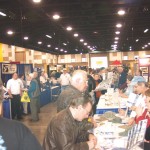By Terry Stephens,

AOPA President Phil Boyer addressed hundreds of visitors at the 2006 Northwest Aviation Conference & Trade Show.
AOPA President Phil Boyer warned hundreds of pilots who attended the 2006 Northwest Aviation Conference & Trade Show, held in Puyallup, Wash., Feb. 26-26, that federal officials appear ready to impose user fees on the general aviation industry to shore up the Federal Aviation Administration’s allegedly weakened Aviation Trust Fund.
Speaking at his 16th consecutive NWACTS gathering, presented by the Washington Aviation Association and a variety of sponsors, Boyer said the FAA’s budget for the next fiscal year, beginning in October, is a $14 billion package that also reduces funds for general airport improvements. He said Secretary of Transportation Norman Mineta, who told an AOPA audience last November that user fees would not solve the FAA’s funding problems, now talks about “new solutions” to the funding crisis without revealing them.
“The FAA is claiming a terrific financial crisis that demands a different manner of funding, but they’ll tell you later how they’re going to use it,” Boyer said. “The airliners say they pay too much into the trust fund for the air traffic control system and that general aviation doesn’t pay enough. Actually, when you look at your airline ticket, you are the ones paying that tax, not the airlines. That system was designed for the airlines. General aviation pilots often don’t even use the system. We’re very incremental users. Any new fees, reportedly to ensure equality (with the airlines), would be very harmful for general aviation pilots.”

Arlington Municipal Airport’s booth promoted its July Northwest EAA Fly-In and Sport Aviation Convention and showed off wall drawings of a new sport pilot hangar and education center planned for the airfield.
Also, Boyer claims, the aviation trust fund actually “showed an uncommitted balance last year of $2.4 billion and a $9.5 billion balance is predicted for this year.” He expects a firm budget from the FAA this spring. As recently as January, Mineta said he expects to see a cost-based plan that will “create a more direct relationship between revenue collected and services provided.”
“All of the House of Representatives are running for re-election this year, along with one-third of the Senate,” Boyer noted. “Hopefully, in an election year, cuts to the FAA budget will be reinstated. The AOPA website will tell you who supports our side, whether they’re running or not.”
Another significant issue for Boyer is Washington Governor Christine Gregoire’s promotion of increased use of ethanol fuels for cars—requiring two percent ethanol in all gasoline in 2008—without providing any exemption for pilots who must use automotive gas for their planes. Engines in antique aircraft and planes in the FAA’s new sport-pilot category would be damaged by the ethanol fuel, possibly causing crashes.
“There is no provision for them to purchase gasoline without ethanol added, as Montana and Idaho have done with similar legislation,” he said, “so we plan a letter-writing campaign to state legislators.”
Boyer also noted that 18 months after FAA approval for sport pilot certification, nearly 600 people have taken the written test and 107 sport-pilot certificates have been issued, as well as 43 certificates for sport-pilot examiners and 83 for designated examiners.
Scott Crossfield

Legendary test pilot Scott Crossfield signs a copy of a book about his flying exploits for fan Larry Johnson (left) of Vancouver, Wash., and Joel Hernandez.
After Boyer’s address, aviation pioneer Scott Crossfield, 85, whose Mach 2 flight in the Douglas D-558-II Skyrocket in 1953 earned him the title of “NHthe fastest man alive,” entertained several hundred admirers with more than an hour of jokes and escapades from his 73 years of flying.
A native of Chehalis, Wash., Crossfield learned to fly when he was 12, and later served as a U.S. Navy pilot and flight instructor during World War II. He worked in the University of Washington’s wind tunnel facility while earning his bachelor’s and master’s degrees in aeronautical engineering.
In 1950, he joined the National Advisory Committee for Aeronautics’ High-Speed Flight Station at Edwards Air Force Base as a research pilot. In just five years, he flew nearly all of the experimental aircraft being tested at Edwards, including the X-1, XF-92, X-4, X-5, D-558-I and the D-558-II Skyrocket. When he left the program to join North American Aviation in 1955 as chief engineering test pilot, he had completed 99 flights in rocket planes, more than any other pilot in the world.
Later, flying the X-15 for North American, his job was to demonstrate the untested plane’s airworthiness at a variety of speeds up to Mach 3. Despite two explosive incidents with the rocket-powered plane, he escaped intact, with dramatic new stories to tell. Later he worked on engineering and systems tests for such programs as the Apollo command and service models and the Saturn II booster rocket, before joining Eastern Airlines to develop air traffic control technologies.
Crossfield focused mostly on telling about his early days of flying rocket-powered aircraft and experimental jets. Test pilot Chuck Yeager gave him his first flight instructions. His early flights with untamed test aircraft soon convinced him he should expect “a guaranteed emergency with every flight.”
“On my first flight, the engineer who set up the airplane under the belly of a B-29 didn’t do it just right, and when it was launched it came off the bomber in a spin,” Crossfield said, showing the audience a series of photos of various planes he’d flown. “I thought that was a unique way to launch an aircraft. Then, someone accused me of hot-dogging, too.”

L to R: Director Dave Waggoner, operations staffer Kara Underwood and operations superintendent Bruce Goetz represented Paine Field at the aviation conference. The booth included display space for the Future of Flight center in Everett.
He recalled another flight when he was wearing moccasins, part of his often casual flight gear, and the window steamed up.
“I took my sock off to rub the windshield,” he said. “My bare foot froze to the rudder pedal. After I landed, I couldn’t get out of the cockpit.”
Moving on to the X-4, Crossfield reflected on one of his more exhilarating flights.
“Nobody ever told me you didn’t do loops in those aircraft,” he said. “I did one at 35,000 feet and lost both engines. I had no control whatsoever until I got one of them going again.”
Crossfield became one of the noted test pilots at Edwards AFB to fly Bell Aircraft’s new X-5, equipped with the first variable swept wing in flight.
“The first problem we found was that it took 10,000 feet to get out of a spin,” he said. “We lost one pilot who went into a spin at 9,000 feet.”
Later, he began flying the XF-92, the first delta-winged jet, which became the model for the F-102 and F-106. He found it very difficult to handle, although “the later fighter versions were excellent aircraft.”
On one of his test flight landings on the dry lakebeds in the Mojave Desert, he learned it was possible to run out of runway, even when it was 14 miles long.
“We had so much room there that we didn’t always have very good brakes on those planes. As I was nearing the end of that lakebed, I pulled to one side and headed for a nearby country road, getting about 100 yards down the road before I stopped. And then they named the road after me,” he said, grinning. “Later, Yeager got one, too, but I never figured out how badly he screwed up to get that road named for him.”
Crossfield noted that as early test pilots, he and others “experienced the unknown on every flight.”
“Three of us together had 20 aviation records, but we never thought about it,” he said. “We were just busy flying. … As a project engineer back then, I think I got about $500 a month. But when you can have a vocation that’s your avocation, you’re the richest person in the world.”
Despite daily risks in flying the test aircraft, he remembers only three times that the situation was so bad he was told to bail out.
“Instead, I just turned off the radio and solved the problem on my own,” he said. “It amused me later to realize that after years of flying those planes in all kinds of weather conditions, speeds and altitudes, as a chief engineer and test pilot, I still didn’t even have an instrument ticket.”
He closed with a story he said he always saves for last, about his Navy time as a flight instructor at Corpus Christi Naval Air Station in Texas.
“I taught students to master the T-6, including pulling it out of a spin,” he said. “This one kid was a victim of his own intense desire to become a Navy aviator. He would only do everything by the book. I told him, ‘I’m going to put the plane into a spin. When I say so, you put the nose down hard and hit the right rudder hard.’
“He pushed the stick forward so hard and fast that his jacket caught his seatbelt and uncoupled it. He flew out of the open canopy onto the left wing. He was hanging onto the side of the cockpit with both hands and his face was white. I never had a student out on the wing before, so I slowed way down and the kid tumbled back into the cockpit. He hooked up his intercom and told me he knew I’d wash him out if he fell off that wing.”
North American Eagle

This T-28 fuselage, used by the Olympic Flight Museum in parades and at air shows, was popular with youth visiting the conference.
The 23rd annual Northwest Aviation Conference & Trade Show was held in the Puyallup Fairgrounds’ new Showplex conference center, providing more than 122,000 square feet of aviation displays and dozens of aviation exhibitors.
Visitors wandered through displays of general aviation aircraft, helicopters and gliders inside the center, but the main attention was a bright red F-104 whose owners are preparing to give a new meaning to “flying low.”
The North American Eagle project, based in Spanaway, Wash., is attempting to set a world speed record with an F-104—on land. Since 1983, the British have held the record, set at 633 miles per hour that year. They added a 763 mph (Mach 1.02) record in 1997.
Retired IBM technician Ed Shadle and Boeing manager Keith Zanghi plan to use the former Edwards AFB chase plane—already designed for supersonic flight—to bring the speed record to the United States. The wingless jet fighter has been tested at more than 300 mph and a 400-mph run is planned soon.
The F-104 Shadle rescued from a scrap pile has historical significance that he didn’t know about when he bought it. While the 1957-vintage Starfighter was flying at Edwards AFB, it was piloted by most of the “Right Stuff” test pilots of the era, including Chuck Yeager, Bill Dana and Scott Crossfield, who stopped to visit with the Eagle crew during the trade show.
Many companies and scores of individuals have volunteered their involvement in the project, but Shadle continues to search for a major corporate sponsor to finance the project to its goal. More information is available at [http://www.landspeed.com].
- Precision Flight Training Inc. of Newberg, Ore., showed off some of its helicopters.
- Ed Shadle, co-owner and driver of the North American Eagle, explains the plans for the F-104 turned race car, destined for an attempt at setting a new supersonic world record for land vehicles.
- Visitors fill several aisles of exhibit booths at the Puyallup Fairgrounds’ new Showplex conference center, providing three times as much space as last year’s gathering.
- The North American Eagle is a wingless F-104 on tires, converted for an attempt at the world’s land speed record, now held by the British with a speed of Mach 1.02. The Eagle’s owners are planning to reach at least 1.05, about 800 mph.















